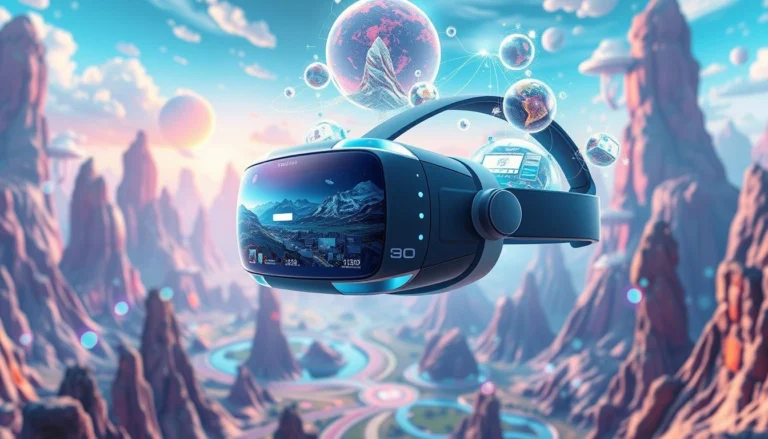Top 2025 Tech Trends for Business Growth and AI Automation
Navigating the Future: Unpacking the Top 2025 Tech Trends for Business Growth and AI Automation
Estimated reading time: 8-10 minutes
Key Takeaways
- The 2025 tech trends prioritize speed, scalability, and user experience in web development, embracing modern frameworks like Next.js and headless CMS WordPress.
- Mobile app development in 2025 favors cross-platform solutions such as Flutter and React Native for efficiency and faster market entry, while focusing on intuitive UI/UX.
- Cloud computing and DevOps are crucial for innovation, with serverless architecture and CI/CD pipelines driving cost efficiency and rapid, reliable deployments.
- AI automation for businesses streamlines operations through workflow automation tools, intelligent chatbots for customer service, and AI-enhanced SaaS features.
- Modern UI/UX design is paramount, emphasizing responsive, accessible, and user-centric experiences as an integral part of successful digital transformation strategies.
Table of Contents
- Web Development in 2025: Speed, Scalability, and User Experience
- Mobile App Development 2025: Choosing Your Cross-Platform Champion
- The Backbone of Innovation: Cloud Computing and DevOps Best Practices
- AI Automation for Businesses: Intelligent Delegation and Unlocking Efficiency
- Crafting Experiences: Modern UI/UX Design for Digital Success
- Strategic Digital Transformation: Empowering Businesses in 2025 and Beyond
- The Future is Now: Partnering for Success in the AI-Driven Era
- Frequently Asked Questions
The digital landscape is in perpetual motion, evolving at a pace that can feel dizzying. For business leaders, entrepreneurs, and forward-thinking professionals, staying ahead of the curve isn’t just an advantage—it’s a necessity. As we look towards 2025, a confluence of innovative technologies is reshaping how businesses operate, interact with customers, and drive growth. Understanding these 2025 tech trends is crucial for crafting resilient strategies and harnessing the power of new tools. At AITechScope, we believe that intelligent AI automation for businesses is at the heart of this transformation, enabling companies to scale operations, reduce costs, and improve efficiency through smart delegation and cutting-edge solutions.
This comprehensive guide delves into the most significant advancements across web development, mobile applications, cloud computing, DevOps, AI automation, and modern UI/UX design. We’ll break down complex concepts into actionable insights, providing a playbook for how these technologies can accelerate your business’s digital transformation journey.
Web Development in 2025: Speed, Scalability, and User Experience
The web remains the primary interface for most businesses, and its evolution continues to prioritize performance, flexibility, and user engagement. Web development trends in 2025 emphasize technologies that deliver lightning-fast experiences and seamless content management.
One of the most prominent shifts is the embrace of frameworks like Next.js for building high-performance websites. As highlighted in research, “Next.js for Small Businesses: Build a Fast Marketing Site in One Weekend,” this framework, built on React, offers server-side rendering (SSR) and static site generation (SSG) capabilities, which are crucial for search engine optimization (SEO) and incredibly fast page loads. For businesses, this translates directly to better user engagement, lower bounce rates, and improved conversion rates. Our real-world case studies show how “5 Simple React Performance Fixes That Reduce Page Load by Seconds” can make a significant difference, with one client experiencing a 60% reduction in page load times—a critical factor for online success.
Another pivotal trend is the move towards headless CMS WordPress. This architecture decouples the content management backend (where you create and manage content) from the frontend (how the content is displayed). By using WordPress as a headless CMS, businesses can leverage its user-friendly content creation interface while benefiting from modern frontend frameworks like React or Next.js for unparalleled flexibility, security, and performance. This approach allows for a highly customized user experience across various platforms (web, mobile, IoT) from a single content source, without the “bloat” often associated with traditional WordPress installations. We focus on “WordPress Without the Bloat: Lightweight Plugins That Actually Help SEO” to ensure our clients get the best of both worlds.
Furthermore, the concept of microservices architecture is extending to the frontend with micro frontends. This approach allows large web applications to be broken down into smaller, independent, and deployable units. While powerful for large enterprises, it’s important to understand “Micro Frontends: When They Help and When They Hurt (Practical Examples).” For many businesses, simpler modular approaches might suffice, but for complex, evolving platforms, micro frontends offer enhanced scalability and team autonomy.
Practical Takeaways for Your Business:
- Prioritize Performance: Invest in modern frameworks like Next.js for marketing sites and critical web applications. Speed equals user satisfaction and better SEO.
- Decouple Your Content: Explore headless CMS solutions to future-proof your content strategy and enable omni-channel delivery.
- Optimize Existing Assets: Regularly audit your website for performance bottlenecks and implement best practices for React performance.
How AITechScope Helps:
AITechScope excels in building high-performance, scalable web applications using cutting-edge frameworks like Next.js and React. Our expertise in website development, coupled with performance optimization techniques and headless CMS integration, ensures your digital storefront is not only visually appealing but also a powerhouse of speed and efficiency. We help businesses leverage these AI-powered web apps to create dynamic, responsive, and intelligent user experiences.
Mobile App Development 2025: Choosing Your Cross-Platform Champion
In the mobile-first world, having a robust mobile presence is non-negotiable. Mobile app development 2025 continues to be dominated by the debate between native development and cross-platform frameworks. While native apps offer the ultimate performance and access to device features, the desire for efficiency and speed to market often leads businesses to cross-platform solutions.
The primary contenders in this space remain Flutter and React Native. Our analysis of “React Native vs Flutter in 2025: Which Is Best for Your Business App?” indicates that both have matured significantly, offering compelling advantages. React Native, backed by Facebook, allows developers to build mobile apps using JavaScript/React, leveraging a vast existing developer ecosystem. Flutter, Google’s UI toolkit, provides a rich set of pre-built widgets and excellent performance for building natively compiled applications from a single codebase (as detailed in “Build a Simple Cross-Platform App with Flutter: From Idea to Play Store”).
The decision between “Flutter vs React Native” often boils down to specific business needs, existing tech stacks, and developer availability. For many startups and businesses looking for rapid iteration and deployment, cross-platform development offers a cost-effective path to reach both iOS and Android users simultaneously. Mobile app UI trends also emphasize intuitive, gesture-based interfaces and deep integration with device features, which both frameworks are well-equipped to handle.
Practical Takeaways for Your Business:
- Embrace Cross-Platform: Unless your app requires highly specialized native features, consider Flutter or React Native for faster development cycles and reduced costs.
- Focus on UI/UX: Regardless of the framework, invest in a responsive UI design that delivers an exceptional user experience across all devices.
- Strategic Choice: Align your mobile development framework choice with your long-term business goals, scalability needs, and available talent pool.
How AITechScope Helps:
AITechScope provides expert consulting on mobile app development strategies, helping businesses navigate the choices between Flutter and React Native. We assist in building and deploying high-quality cross-platform applications, ensuring your mobile presence is effective, engaging, and aligned with your business objectives.
The Backbone of Innovation: Cloud Computing and DevOps Best Practices
The underlying infrastructure that powers digital businesses is increasingly migrating to the cloud. Cloud computing and DevOps are no longer just buzzwords but fundamental pillars of modern IT strategy, offering unparalleled scalability, flexibility, and cost efficiency.
Serverless architecture is a game-changer for many businesses, particularly startups. As seen in “Serverless on AWS: Create a Cost-Efficient Backend That Scales Automatically,” serverless platforms (like AWS Lambda, Google Cloud Functions, Azure Functions) allow developers to build and run applications and services without managing servers. You only pay for the compute time you consume, making it incredibly cost-efficient for variable workloads and ideal for “serverless backend for startups” or “serverless AWS cost example” scenarios. This model frees up engineering teams to focus purely on code and innovation, rather than infrastructure management.
Alongside serverless, DevOps best practices are essential for accelerating development cycles and ensuring reliable deployments. Continuous Integration and Continuous Deployment (CI/CD) pipelines are critical. For small teams, implementing “CI/CD for Small Teams: Automated Deployments Without the Headache” using tools like GitHub Actions (as in a “GitHub Actions deploy tutorial”) can drastically improve efficiency, reduce errors, and speed up the delivery of new features. This automation streamlines the entire software development lifecycle, from code commit to deployment.
Finally, for businesses still operating with legacy systems, cloud migration strategy is a key consideration. The process of moving applications and data to the cloud without disruption is complex but vital for future growth. Research like “How to Move Your Legacy App to the Cloud Without Breaking It” provides practical steps, emphasizing careful planning, incremental migration, and robust testing to minimize risks.
Practical Takeaways for Your Business:
- Embrace Serverless: Evaluate serverless architectures for new projects or to refactor existing components, especially for variable workloads to optimize costs.
- Automate Your Deployment: Implement CI/CD pipelines, even for small teams, to accelerate development, improve reliability, and free up valuable time.
- Strategize Cloud Migration: If you have legacy systems, develop a clear cloud migration strategy to unlock scalability, security, and efficiency benefits.
How AITechScope Helps:
AITechScope provides comprehensive consulting on cloud migration strategy and implementing DevOps best practices. We help businesses design and implement scalable, cost-efficient serverless backends and set up robust CI/CD automation pipelines using tools like n8n and GitHub Actions, ensuring smooth and reliable software development 2025.
AI Automation for Businesses: Intelligent Delegation and Unlocking Efficiency
Perhaps no other trend holds as much transformative power as AI automation for businesses. From streamlining repetitive tasks to revolutionizing customer interactions, AI is no longer a futuristic concept but a practical tool for driving efficiency and innovation.
One of the most immediate and impactful applications is workflow automation tools combined with AI. Businesses can “Automate Repetitive Tasks with No-Code Tools + AI (Save 5–10 Hours/Week)” by integrating AI into routine operations. This includes tasks like data entry, email triage, report generation, and customer support. The goal is intelligent delegation, where AI handles the mundane, allowing human employees to focus on strategic, creative, and complex problem-solving.
Chatbot automation is another area seeing rapid advancements. “How Small Businesses Use Chatbots to Save Time: Real Workflows That Work” illustrates how AI chatbots for customer service can handle common inquiries, provide instant support, and even guide users through complex processes 24/7. This improves customer satisfaction, reduces the burden on human support teams, and frees them to tackle more nuanced issues. Beyond customer service, chatbots can be integrated into internal workflows for HR, IT support, or sales qualification.
The impact extends to existing software as a service (SaaS) products. “Make Your SaaS Smarter: 3 Low-Effort AI Features That Delight Users” suggests simple yet powerful AI integrations, such as intelligent search, personalized recommendations, or automated summarization, that can significantly enhance user experience without requiring a complete overhaul.
However, it’s also crucial to acknowledge the reality that “AI Fails… You can’t always get what you want!” as one research article notes. While AI is powerful, it’s not a silver bullet. Strategic implementation, careful data management, and understanding the limitations of current AI models are paramount. AI should augment human capabilities, not replace critical human oversight.
Practical Takeaways for Your Business:
- Identify Automation Opportunities: Conduct an audit of your business processes to pinpoint repetitive, rule-based tasks that can be automated with AI.
- Leverage AI Chatbots: Implement AI chatbots for customer service and internal support to improve response times and free up staff.
- Enhance Existing Tools: Look for ways to integrate low-effort AI features into your existing software and workflows to provide smarter experiences.
How AITechScope Helps:
This is AITechScope’s core expertise. We specialize in AI-powered automation, leveraging platforms like n8n for sophisticated workflow automation tools. Our virtual assistant services are built on intelligent delegation, allowing businesses to harness AI to scale operations, reduce costs, and improve efficiency. From designing custom chatbot automation solutions to integrating AI into your existing systems, our AI consulting helps you strategically adopt these powerful technologies.
Crafting Experiences: Modern UI/UX Design for Digital Success
While technology underpins everything, the user’s perception and interaction are paramount. Modern UI/UX design is about creating digital products that are not only functional but also intuitive, enjoyable, and accessible. In 2025, the emphasis on user-centric design will only intensify.
Responsive UI design is a given, ensuring seamless experiences across desktops, tablets, and mobile devices. However, good design goes beyond responsiveness; it’s about anticipating user needs and creating engaging interfaces. This includes prioritizing clarity, simplicity, and visual hierarchy.
Accessibility is also moving from a niche consideration to a fundamental design principle. “Designing Accessible Buttons: A Non-Designer’s Guide (Figma Tips)” illustrates how even small design choices can significantly impact user experience for individuals with disabilities. Building accessible interfaces not only broadens your audience but also often leads to better design for everyone.
The combination of sophisticated backend technologies and elegant frontend design is what truly differentiates a product. Businesses that invest in SaaS product optimization understand that continuous refinement of the user interface and experience leads to higher engagement, retention, and ultimately, profitability.
Practical Takeaways for Your Business:
- Invest in User Research: Understand your users’ needs, behaviors, and pain points to inform your design decisions.
- Prioritize Accessibility: Design with accessibility in mind from the outset to create inclusive digital products.
- Iterate and Optimize: Continuously collect user feedback and use it to refine your UI/UX, driving performance optimization techniques beyond just speed.
How AITechScope Helps:
AITechScope understands that exceptional user experience is critical for digital success. Our website development services are grounded in modern UI/UX design principles, creating intuitive, aesthetically pleasing, and highly functional interfaces. We ensure your digital presence not only looks great but also provides an optimal experience for all users, driving engagement and conversion.
Strategic Digital Transformation: Empowering Businesses in 2025 and Beyond
Bringing all these elements together is the overarching goal of digital transformation strategies. For businesses of all sizes, this isn’t just about adopting new tech; it’s about fundamentally rethinking processes, culture, and customer engagement.
For small companies, the idea of digital transformation can seem daunting, but it doesn’t have to be. “Digital Transformation on a Budget: 7 Steps Small Companies Can Start Today” provides a roadmap for incremental, impactful changes. This includes identifying key pain points, leveraging no-code/low-code solutions, and focusing on immediate ROI. Tech innovation for small businesses is about smart, strategic adoption, not massive overhauls.
Enterprise digital adoption requires a more complex approach, often involving a shift towards microservices architecture to break down monolithic applications into manageable, independently deployable services. This enhances agility, scalability, and resilience. Effective performance optimization techniques and a well-defined tech stack for modern businesses are crucial for sustaining competitive advantage.
Ultimately, the goal is workflow optimization—making every process, from customer service to internal operations, as efficient and effective as possible. This involves leveraging AI, automation, and cloud technologies to create seamless, data-driven workflows that reduce manual effort and maximize output.
Practical Takeaways for Your Business:
- Holistic Strategy: Develop a comprehensive digital transformation strategy that integrates technology, processes, and people.
- Start Small, Scale Smart: For small businesses, identify quick wins and incremental changes that deliver immediate value before scaling.
- Continuous Learning: Stay informed about emerging technologies and be prepared to adapt your strategy as the landscape evolves.
How AITechScope Helps:
AITechScope is your partner in orchestrating successful digital transformation strategies. We provide expert AI consulting to help you identify the right technologies, develop tailored automation solutions using n8n, and optimize your workflows. Whether you’re a startup seeking to build a robust tech stack for modern businesses or an established enterprise looking for SaaS product optimization, we offer the expertise to navigate these complexities and achieve your business goals.
The Future is Now: Partnering for Success in the AI-Driven Era
The 2025 tech trends we’ve explored—from advanced web and mobile development to transformative cloud and AI automation for businesses—are not just abstract concepts. They are practical tools ready to be deployed to enhance efficiency, reduce costs, and accelerate growth. The businesses that embrace these changes proactively will be the ones that thrive.
At AITechScope, we are passionate about empowering businesses to harness the full potential of these technologies. Our specialization in AI-powered automation, n8n workflow development, AI consulting, and website development positions us as your trusted partner in this evolving digital landscape. We help you move beyond simply reacting to trends, enabling you to strategically integrate cutting-edge AI and automation solutions that drive tangible results and optimize your operations for the future.
Ready to transform your business with intelligent AI automation and expert digital strategies?
Explore AITechScope’s AI Automation and Consulting Services Today!
Frequently Asked Questions
What are the top web development trends for 2025?
Key web development trends for 2025 include the adoption of performance-focused frameworks like Next.js, the shift to headless CMS WordPress for greater flexibility and scalability, and the exploration of micro frontends for complex applications. The focus is on speed, user experience, and efficient content management.
Should my business choose Flutter or React Native for mobile app development?
The choice between Flutter and React Native depends on your specific business needs, existing tech stack, and developer availability. Both are mature cross-platform frameworks offering significant advantages for rapid iteration and deployment, allowing you to reach both iOS and Android users cost-effectively. For highly specialized native features, native development might be considered.
How can AI automation benefit my business?
AI automation for businesses can significantly enhance efficiency by automating repetitive tasks, streamlining workflows, and improving customer interactions through intelligent chatbots. It allows human employees to focus on strategic initiatives, reduces operational costs, and provides smarter, more responsive services. It’s about intelligent delegation to scale operations.
What is the importance of UI/UX design in 2025?
Modern UI/UX design is critical for digital success in 2025, ensuring that digital products are intuitive, enjoyable, and accessible. It goes beyond responsiveness to anticipate user needs, create engaging interfaces, and prioritize accessibility for all users. Investing in good UI/UX leads to higher user engagement, retention, and overall profitability.
How can small businesses approach digital transformation on a budget?
Small businesses can approach digital transformation by focusing on incremental, impactful changes. This includes identifying key pain points, leveraging cost-effective no-code/low-code solutions for workflow optimization, and prioritizing changes that offer immediate ROI. The strategy should be smart, strategic adoption rather than massive overhauls, allowing for scaling as benefits are realized.







